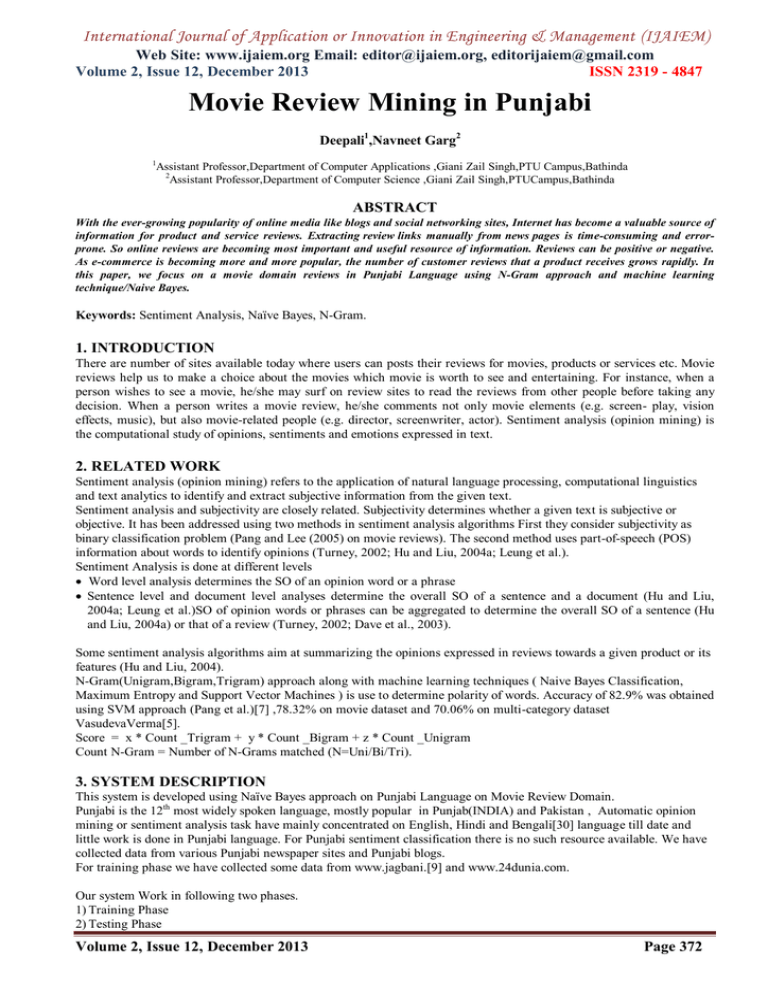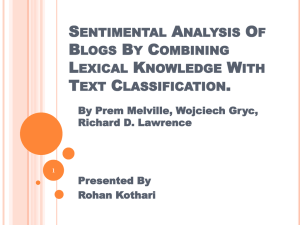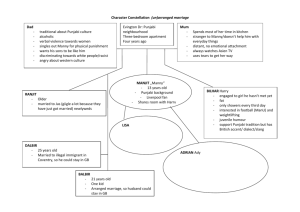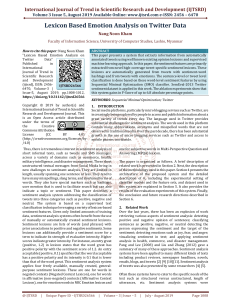Movie Review Mining in Punjabi Web Site: www.ijaiem.org Email: ,
advertisement

International Journal of Application or Innovation in Engineering & Management (IJAIEM) Web Site: www.ijaiem.org Email: editor@ijaiem.org, editorijaiem@gmail.com Volume 2, Issue 12, December 2013 ISSN 2319 - 4847 Movie Review Mining in Punjabi Deepali1,Navneet Garg2 1 Assistant Professor,Department of Computer Applications ,Giani Zail Singh,PTU Campus,Bathinda 2 Assistant Professor,Department of Computer Science ,Giani Zail Singh,PTUCampus,Bathinda ABSTRACT With the ever-growing popularity of online media like blogs and social networking sites, Internet has become a valuable source of information for product and service reviews. Extracting review links manually from news pages is time-consuming and errorprone. So online reviews are becoming most important and useful resource of information. Reviews can be positive or negative. As e-commerce is becoming more and more popular, the number of customer reviews that a product receives grows rapidly. In this paper, we focus on a movie domain reviews in Punjabi Language using N-Gram approach and machine learning technique/Naive Bayes. Keywords: Sentiment Analysis, Naïve Bayes, N-Gram. 1. INTRODUCTION There are number of sites available today where users can posts their reviews for movies, products or services etc. Movie reviews help us to make a choice about the movies which movie is worth to see and entertaining. For instance, when a person wishes to see a movie, he/she may surf on review sites to read the reviews from other people before taking any decision. When a person writes a movie review, he/she comments not only movie elements (e.g. screen- play, vision effects, music), but also movie-related people (e.g. director, screenwriter, actor). Sentiment analysis (opinion mining) is the computational study of opinions, sentiments and emotions expressed in text. 2. RELATED WORK Sentiment analysis (opinion mining) refers to the application of natural language processing, computational linguistics and text analytics to identify and extract subjective information from the given text. Sentiment analysis and subjectivity are closely related. Subjectivity determines whether a given text is subjective or objective. It has been addressed using two methods in sentiment analysis algorithms First they consider subjectivity as binary classification problem (Pang and Lee (2005) on movie reviews). The second method uses part-of-speech (POS) information about words to identify opinions (Turney, 2002; Hu and Liu, 2004a; Leung et al.). Sentiment Analysis is done at different levels Word level analysis determines the SO of an opinion word or a phrase Sentence level and document level analyses determine the overall SO of a sentence and a document (Hu and Liu, 2004a; Leung et al.)SO of opinion words or phrases can be aggregated to determine the overall SO of a sentence (Hu and Liu, 2004a) or that of a review (Turney, 2002; Dave et al., 2003). Some sentiment analysis algorithms aim at summarizing the opinions expressed in reviews towards a given product or its features (Hu and Liu, 2004). N-Gram(Unigram,Bigram,Trigram) approach along with machine learning techniques ( Naive Bayes Classification, Maximum Entropy and Support Vector Machines ) is use to determine polarity of words. Accuracy of 82.9% was obtained using SVM approach (Pang et al.)[7] ,78.32% on movie dataset and 70.06% on multi-category dataset VasudevaVerma[5]. Score = x * Count _Trigram + y * Count _Bigram + z * Count _Unigram Count N-Gram = Number of N-Grams matched (N=Uni/Bi/Tri). 3. SYSTEM DESCRIPTION This system is developed using Naïve Bayes approach on Punjabi Language on Movie Review Domain. Punjabi is the 12th most widely spoken language, mostly popular in Punjab(INDIA) and Pakistan , Automatic opinion mining or sentiment analysis task have mainly concentrated on English, Hindi and Bengali[30] language till date and little work is done in Punjabi language. For Punjabi sentiment classification there is no such resource available. We have collected data from various Punjabi newspaper sites and Punjabi blogs. For training phase we have collected some data from www.jagbani.[9] and www.24dunia.com. Our system Work in following two phases. 1) Training Phase 2) Testing Phase Volume 2, Issue 12, December 2013 Page 372 International Journal of Application or Innovation in Engineering & Management (IJAIEM) Web Site: www.ijaiem.org Email: editor@ijaiem.org, editorijaiem@gmail.com Volume 2, Issue 12, December 2013 ISSN 2319 - 4847 In training phase, we train the system to analyse the paragraph. As training data for the English text classification is available on net, but for Punjabi no data is available. To generate the corpus we gathered data from Punjabi newspaper site, Punjabi blogs. Some data gathered by translating the Hindi text into Punjab using online Web Hindi to Punjabi Translator System (www.h2p.learnpunjabi.com). We first gathered the classified data from various web resources. Data contain user rating from 1 to 5. Figure 1 Training Phase Figure 2 Testing Phase 1. Normalization Before processing the text we need to normalize the paragraph text. In this pass all the punctuation marks found are deleted. 2. Tokenize First tokenize the input paragraph into sentence. Paragraph is tokenize in sentence using delimiter the dandi (“।“). After tokenizing each sentence, we further split the sentence into word using the delimiter space (“ “). 3. Finding Polarity In this pass, we check the polarity score (Positive or Negative) of all the words in the paragraph. Some of the words do not affect the polarity of the score. E.g. State Name, Country Name, Pronoun etc. does not affect our polarity of the paragraph. So we made database of all such words named “EXCLUDED_WORDS”. If the words appear in the paragraph then there polarity score will be ignored. 4. Final Polarity Conclusion If the Positive score is greater than the Negative score then we summed up as POSITIVE POLARITY. If the Negative score is greater than the Positive score then we summed up as NEGATIVE POLARITY. If the score equal then we labelled as NETRUAL POLARITY. Algorithm 1. We take the text to be input. 2. Calculate the probability. 3. If trigram found in dictionary we get the score as positive or negative value but if we get neutral value we split it into bigram. 4. If bigram found in dictionary we get the score as positive or negative value but if we get neutral value then split it into unigram. 5. If unigram found in dictionary we get the score as positive or negative value but if we get neutral value then discard it. ਿਫਲਮ ਵੇਖਣ ਤ ਬਾਅਦ ਲੱਗਦਾ ਹੈ ਿਕ ਅਕਸ਼ੈ ਕੁਮਾਰ ਹੁਣ ਹਰ ਿਫਲਮ ਨੂੰ ਿਧਆਨ ਦੇ ਨਾਲ ਕਰ ਰਹੇ ਹਨ|ਿਪੰ ਡ ਦੇ ਮਜਾਿਕਆ ਨੌਜਵਾਨ ਦਾ ਰੋਲ ਅਕਸ਼ੈ ਕੁਮਾਰ ਨ ਬਹੁਤ ਵਧੀਆ ਢੰ ਗ ਨਾਲ ਿਨਭਾਇਆ|ਇਸ ਦੇ ਇਲਾਵਾ ਕੈਟਰੀਨਾ ਕੈਫ ਨ ਵੀ ਆਪਣੇ ਅਿਭਨ ਨਾਲ ਿਕਸੇ ਤਰ ਦੀ ਬੇਈਮਾਨੀ ਨਹ ਕੀਤੀ|ਿਫਲਮ ਿਵੱ ਚ ਓਮਪੁਰੀ, ਸੋਨੰ ੂਸੂਦ, ਓਮਪੁਰੀ,ਰਣਬੀਰ ਸ਼ੌਰੀ,ਯਸ਼ਪਾਲ ਸ਼ਰਮਾ,ਜਾਵੇਦ ਜਾਫਰੀ ਨ ਵੀ ਆਪਣਾ ਰੋਲ ਬਾਖ਼ੂਬੀ ਿਨਭਾਇਆ|ਿਕਰਨ ਖੇਰ ਨ ਹਰ ਿਫਲਮ ਦੀ ਤਰ ਇਸ ਿਫਲਮ' ਚ ਵੀ ਬਹੁਤ ਵਧੀਆ ਅਿਭਨ ਕੀਤਾ|ਇਸ ਦੇ ਇਲਾਵਾ ਜੇਕਰ ਿਫਲਮ ਦਾ Volume 2, Issue 12, December 2013 Page 373 International Journal of Application or Innovation in Engineering & Management (IJAIEM) Web Site: www.ijaiem.org Email: editor@ijaiem.org, editorijaiem@gmail.com Volume 2, Issue 12, December 2013 ISSN 2319 - 4847 ਿਮਊਿਜ਼ਕ ਵੇਿਖਆ ਜਾਵੇ ਤ ਉਹਵੀ ਗਜ਼ਬਦਾਹੈ. ਹਰ ਗੀਤ ਲੋ ਕ ਦੇ ਿਦਲ ਨੂੰ ਟੁੰ ਬਦਾ ਹੈ|ਕੁੱ ਲ ਿਮਲਾ ਕੇ ਿਫਲਮ ਆਪਣੇ ਨਾਮ ਅਤੇ ਦਰਸ਼ਕ ਦੀ ਉਮੀਦ ਤੇ ਖ਼ਰੀ ਉਤਰਦੀਹੈ| After watching the film it seems that Akshay Kumar is doing all his films with full concentration. The role of funny youth of village was well played by Akshay kumar. Katrina kaif also had not done any dishonesty with her acting. Om Puri, SonuSud, Ranbir Shourie, Yashpal Sharma, Javed Jafari all had also played their roles very well .Like in every film KironKher also did good in this film. Now if we talk about the music of this film its also superb and every song touches the heart .On the whole the film with his work and name proved over audience expectations. The Above paragraph has – Positive Polarity Algorithm to find the Positive Words Frequency for each review paragraph in Positive_Corpus do tokenize(R) -> Sentences(R) for each sentence s in S do tokenize(S) -> Words(W) for each word w in W do if word w already exist in the frequency list then increment the value of the frequency value of w by 1 else if word w does not exist in the frequency list then add the word to the PF list with frequency value 1 end for end for Algorithm to find the Negative Words Frequency for each review paragraph in Negative_Corpus do tokenize(R) -> Sentences(R) for each sentence s in S do tokenize(S) -> Words(W) for each word w in W do if word w already exist in the frequency list then increment the value of the frequency value of word w by 1 else if word w does not exist in the frequency list then add the word w to the NF list with frequency value 1 end for end for Naïve Bayes Classifier Naive Bayes classification [13] is based on Bayes rule ,it is machine learning technique. Naive Bayes performs well on problems which are related to linearly separable and non-linearly separable. Bayes rule: P (c | d) = P(c) P (d | c) (1) P (d) Where P (d) plays no role in selecting c*. To estimate the term P (d | c), Naive Bayes decomposes it by assuming the fi's are conditionally independent given d's class: PNB(c | d):= P(c) ( P (fi | c ) n і (d)) (2) P (d) N-Grams An N-Gram model is used [23] in probability for predicting the next item in such a sequence in the form of a (n-1) order Markov model .N-Gram model can Unigram, Bigram ,trigram etc. Example of N-gram “not good camera”, here unigram formed are ‘not’,’ good’,’ camera’ and for bigram we have “good not” and “camera good”. 4. RESULTS Based on the experiments performed we concluded following results [Refer to Table 1] TABLE 1 Accuracy of system N-Gram Accuracy Unigram 75.5 Bigram 52.5 Volume 2, Issue 12, December 2013 Page 374 International Journal of Application or Innovation in Engineering & Management (IJAIEM) Web Site: www.ijaiem.org Email: editor@ijaiem.org, editorijaiem@gmail.com Volume 2, Issue 12, December 2013 ISSN 2319 - 4847 Trigram (Unigram+Bigram+Trigram) Weightage results Average results 60.5 54.5 51.5 61.5 5. CONCLUSION AND FUTURE WORK In future work we are experimenting on rule-based approach in which we take a list of positive and negative words. Main problem while dealing with sentiment analysis on reviews is that reviews span over multiple sentences. There are cases when a review contains multiple sentences and among them few sentences have opposite sentiment. For eg.“Consider this review” This mobile phone has awesome features but the camera really sucks”. In this sentence, the part before ’but’ is positive and the part after but is negative. This review is neither positive nor negative and fails while classifying. References [1] Minqing Hu and Bing Lu (2004), “Mining and Summarizing Customer Reviews”. ACM New York,pp -168-177, KDD‟04. [2] Naïve Bayes Classifier, http://en.wikipedia.org/wiki/Naive_Bayes_classifier. [3] RudyPrabowo and Mike Thelwall (2009)”Sentiment Analysis: A Combined Approach”, pp 143-157,ScienceDirect-09. [4] Proceedings of the Workshop on Sentiment Analysis where AI meets Psychology (SAAIP), IJCNLP 2011, pp 1,Chiang Mai, Thailand, November 13, 2011. [5] AkshatBakliwal, AnkitPatil, PiyushArora,VasudevaVarma,“Towards Enhanced Opinion Classification using NLP Techniques”, Proceedings of the Workshop on Sentiment Analysis where AI meets Psychology (SAAIP),Chiang Mai, Thailand, November 13, 2011 ,pp101-107, IJCNLP 2011. [6] Kushal Dave, Steve Lawrence, and David M. Pennock. Mining the peanut gallery: Opinion extraction and semantic classification of product reviews.Pp 519–528, 2003. [7] Bo Pang, Lillian Lee, and ShivakumarVaithyanathan.Thumbs up? Sentiment classification using machine learning techniques. In Proceedings of the 2002 Conference on Empirical Methods in Natural Language Processing (EMNLP), pp 79–86, 2002. [8] Peter Turney. Thumbs up or thumbs down? Semantic orientation applied to unsupervised classification of reviews. pp 417–424, 2002. [9] www.jagbani.in [10] www.punjabitribuneonline.com [11] www.navapanga.com [12] www.ajitjalandhar.com [13] N-gram, http://en.wikipedia.org/wiki/N-gram. [14] Support Vector Machine" Internet Source,www.statsoft.com/textbook/support-vector-machines/ accessed on Marach 15, 2011. [15] Minqing Hu and Bing Liu, (2005) “opinion Extraction and summarization on web”, pp 1621-1624,AAAI-05. [16] Precision and Recall, http://en.wikipedia.org/wiki/Precision_and_recall. [17] WordNet, http://wordnet.princeton.edu/. [18] Vishal Goyal, AnkurRana ,Vimal K. Soni,(2011) “Renaissance of Opinion Mining”,pp 60-67,(2011). [19] Amitava Das and SivajiBandyopadhyay (2010).“SentiWordNet for Indian Languages”,pp 56-63, AFNLP-10. [20] Amitava Das and SivajiBandyopadhyay.(2010).“Opinion-Polarity Identification in Bengali”,pp- 169-182, ICCPOL10. [21] Faraaz Ahmed, Barath Ashok, SaswatiMukherjee,MeenakshiSundaram, Murugeshan, Ajay Sampath(2008).“Effect of Modifiers for Sentiment Classification of Reviews”, ICON-08. [22] Lun-Wei Ku, Yu Thing and Liang Hsin-His Chen. (2006). “Opinion Extraction, Summarization and Tracking”,pp 100- 107, AAAI-06. [23] Minqing Hu and Bing Liu, (2005) “opinion Extraction and summarization on web”, pp 1621-1624,AAAI-05. [24] www.24dunia.com. Volume 2, Issue 12, December 2013 Page 375


